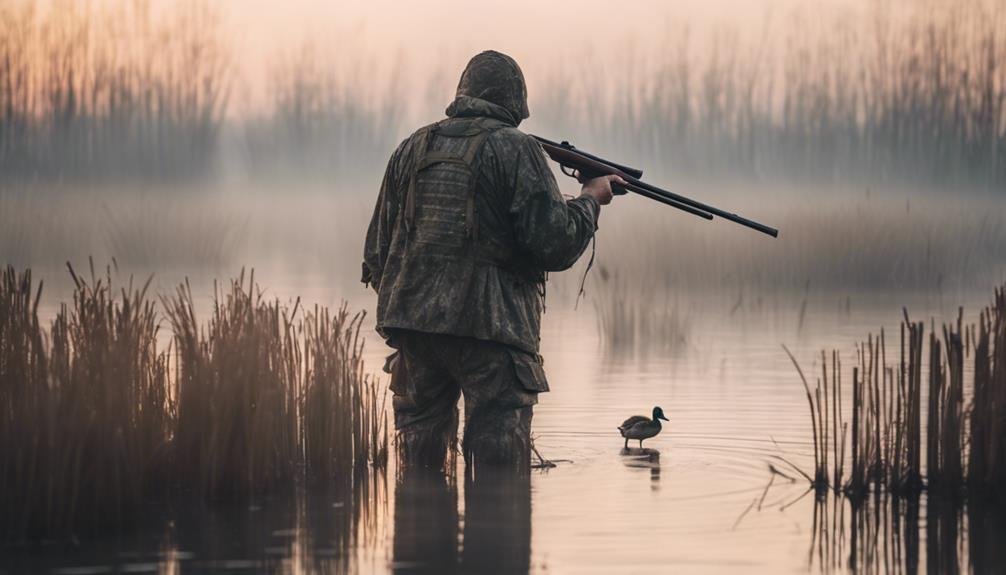Mastering the art of decoy setup strategies is essential for successful duck hunting. Effective decoy placement relies on factors such as wind direction, water conditions, and sun position. Adapting to changing environmental conditions and creating a realistic spread can increase hunting success. A well-crafted decoy setup can convince ducks that they've stumbled upon a safe and desirable spot to land. By understanding decoy spacing, placement, and maintenance, hunters can create a realistic arrangement that mimics natural behavior. As you explore the intricacies of decoy setup strategies, you'll discover the secrets to a fruitful hunt, and uncover the techniques that will take your hunting skills to the next level.
Key Takeaways
- Effective decoy placement relies on wind direction, water conditions, and sun position to create a realistic spread that attracts ducks.
- Adapting to changing water conditions, such as murky or clear water, can greatly impact hunting success.
- Decoy spacing is vital, with optimal spacing at 10-15 feet apart to create a realistic spread and avoid overcrowding.
- Understanding duck behavior and hunting psychology can maximize the effectiveness of specific decoy setups, such as the U, J, and blob setups.
- Proper decoy maintenance, storage, and setup are crucial to ensuring the allure of decoys and increasing hunting success.
Decoy Setup Strategies Revealed
When it comes to decoy setup strategies, understanding the nuances of different layouts and adapting to environmental conditions is essential for a successful duck hunting experience. Effective decoy placement relies on factors such as wind direction, water conditions, and sun position. Regular decoy maintenance is vital to guarantee a realistic spread, as dirty or damaged decoys can deter ducks. In addition, adapting to changing water conditions, such as murky or clear water, can greatly impact hunting success. By understanding the intricacies of decoy setup strategies and adapting to environmental conditions, hunters can increase their chances of attracting ducks and enjoying a successful hunting experience.
Mastering the U Decoy Setup
The U decoy setup, a timeless and versatile strategy, has proven its effectiveness in various environmental conditions, making it a staple in many duck hunters' arsenals. By understanding duck behavior and hunting psychology, hunters can maximize the U setup's potential. The curved line of decoys creates a sense of comfort and security for ducks, drawing them in with an irresistible allure. Wind direction and sun position are key considerations when setting up the U, as they can greatly impact the spread's effectiveness. By adapting the U's length, width, and density to environmental conditions, hunters can create an irresistible haven for ducks, making it an essential tool in their hunting arsenal.
The J Setup Advantage
In contrast to the U setup, the J setup offers a unique advantage in crosswind conditions, particularly when the sun and wind are taken into account, making it a valuable addition to any duck hunter's repertoire. The J setup's hook shape creates an ideal landing spot for ducks, and by adjusting the setup, hunters can encourage birds to land closer to their position. In crosswind hunting, the J setup's flexibility allows hunters to adapt to changing wind directions, making it an effective strategy for attracting ducks. By understanding duck behavior and adjusting the J setup accordingly, hunters can increase their chances of success in crosswind conditions. By incorporating the J setup into their arsenal, duck hunters can improve their skills and fill their bags with more ducks.
Blob Setup for Poor Weather
Duck hunters facing poor weather conditions, characterized by swirling winds and gray skies, can turn to the blob setup, a versatile and effective strategy that creates a sense of chaos, mimicking the ducks' natural behavior in such environments. This setup involves scattering decoys from 15 to 60 yards away in a loose spread with no rhyme or reason, creating a sense of disorder. To enhance the setup, incorporate motion decoys or jerk strings to create movement, attracting birds and simulating the natural behavior of ducks in poor weather conditions. By positioning motion decoys 5 to 10 yards upwind of the ideal landing zone, hunters can increase their chances of success in these challenging weather conditions.
Decoy Placement Essentials
Proper decoy placement forms the backbone of a successful duck hunting strategy, as it can make all the difference between a fruitful hunt and a dismal one. When it comes to decoy placement, consideration of water depth and decoy weight is vital. Here are three essential tips to keep in mind:
- Water Depth: Place decoys in areas with minimal water depth, around 1-3 feet, to create a natural-looking spread.
- Decoy Weight: Use weighted decoys in areas with strong currents or windy conditions to prevent them from drifting away.
- Decoy Spacing: Space decoys 10-15 feet apart to create a realistic spread and avoid overcrowding.
Creating a Realistic Spread
A well-crafted decoy spread is essential to convincing ducks that they've stumbled upon a safe and desirable spot to land, and a critical component of this is creating a realistic arrangement of decoys that mimics the natural behavior of ducks. To achieve this, consider the water clarity and bird behavior of the area you're hunting. In clear water, decoys should be spaced farther apart to create a more natural-looking spread, while in murkier waters, decoys can be grouped closer together. Observe the bird behavior of the ducks you're hunting, taking note of their feeding patterns and social structures. By incorporating these elements into your decoy spread, you'll be well on your way to creating a realistic and effective arrangement that will attract ducks to your hunting spot.
Decoy Spacing and Placement
When setting up a decoy spread, one of the most critical factors to take into account is the spacing and placement of individual decoys, as this can greatly impact the perceived authenticity of the arrangement. Proper spacing and placement can create a sense of realism, enticing ducks to land among the decoys. Consider the following key considerations for optimal decoy placement:
- Water Depth: Place decoys in areas with varying water depths to mimic natural habitats, such as shallow water for mallards and deeper water for divers.
- Decoy Realism: Mix drake and hen decoys to create a natural-looking spread, and use a combination of floating and weighted decoys to add movement and realism.
- Visual Appeal: Space decoys 10-15 feet apart to create a natural-looking spread, and avoid placing them in areas with excessive vegetation, which can conceal the decoys.
Tips for Hunting Small Water
Hunting small water bodies, such as potholes, marshes, or small lakes, requires a tailored approach, as the confined space demands precise decoy placement and strategic hunting techniques. In these environments, water clarity plays a pivotal role, as clear water allows ducks to spot decoys from a distance, while murky water requires a more subtle approach. Understanding bird behavior is also essential, as ducks in small water bodies tend to be more cautious and selective. Hunts should focus on creating a natural-looking spread, taking into account wind direction and sun position, to increase the chances of attracting ducks. By adapting to the unique characteristics of small water bodies, hunters can capitalize on the intimate setting and bag their limit.
Maximizing Decoy Effectiveness
To maximize decoy effectiveness, it's essential to examine the entire spread, from the type of decoys used to their placement and movement, as each element plays a pivotal role in convincing ducks to land. Understanding water conditions and hunter psychology is paramount in creating a convincing spread. Three key considerations to optimize decoy effectiveness are:
- Decoy placement: Place decoys in areas with minimal vegetation and good visibility, taking into account wind direction and sun position.
- Decoy movement: Use motion decoys or jerk strings to create movement, especially in poor weather conditions.
- Decoy realism: Mix drake and hen decoys to create a realistic spread, and use a combination of floating and weighted decoys to mimic natural behavior.
Hunting Success Factors
Ducking into the right location, at the right time, with the right gear, and employing effective decoy strategies are just a few of the critical factors that separate successful duck hunters from the rest. A hunter's mindset also plays a significant role in achieving success. A positive and patient mindset can make all the difference in staying focused and adaptable in the field. Additionally, hunting in areas with good water quality can increase the chances of attracting ducks.
| Factor | Description | Importance |
|---|---|---|
| Location | Hunting in areas with good water quality and suitable habitat | High |
| Gear | Having the right gear, including decoys, blinds, and clothing | Medium |
| Mindset | Maintaining a positive and patient mindset | High |
Advanced Decoy Techniques
Beyond the basics of decoy setup and placement, advanced decoy techniques can substantially enhance a hunter's success, particularly when it comes to convincing wary ducks to commit to a landing. One key aspect is Decoy Maintenance, ensuring decoys are clean and free of damage to maintain their allure.
Advanced techniques also involve adapting to Water Conditions. For instance:
- Wind-driven decoy placement: Adjust decoy spacing and density based on wind direction and speed to create a natural-looking spread.
- Water clarity considerations: Use decoys with more subdued colors in murky waters and brighter colors in clear waters to maximize visibility.
- Water level adaptations: Adjust decoy placement based on water levels to create a realistic spread, taking into account exposed or submerged structures.
Frequently Asked Questions
How Do I Store My Decoys When Not in Use to Prevent Damage?
To prevent damage, store decoys in a protective case or bag, utilizing storage systems with individual compartments and dividers, ensuring Decoy Protection and maintaining their effectiveness for future hunting excursions.
Can I Use Decoys in Saltwater Environments Without Damaging Them?
When using decoys in saltwater environments, it's essential to select decoys with saltwater-resistant coatings and marine materials to prevent corrosion and damage, ensuring a successful hunting experience.
What Is the Ideal Number of Decoys for a Small Hunting Party?
"Imagine a symphony of decoys, strategically placed to entice ducks. For a small hunting party, 6-12 decoys suffice, spaced 10-15 feet apart to create a natural spread, allowing for subtle hunter movement and effective camouflage."
Can I Use Homemade Decoys or Are Commercial Ones Better?
When considering homemade versus commercial decoys, DIY enthusiasts can create realistic spreads using DIY materials, but commercial decoys often offer superior decoy realism, making them a worthwhile investment for serious hunters seeking peak results.
How Often Should I Replace My Decoys to Maintain Effectiveness?
"As the seasons unfold, like a canvas of worn-out brushstrokes, your decoys' effectiveness fades. Rotate your spread regularly to maintain realism, swapping in fresh decoys every 2-3 seasons to keep your pattern looking vibrant and enticing to wary waterfowl."
Conclusion
To summarize, the subtle nuances of decoy setup strategies hold the key to revealing a successful duck hunt. As the saying goes, 'the devil is in the details,' and it is the careful consideration of wind direction, sun position, and water conditions that separates the novice from the seasoned hunter. By mastering the art of decoy placement, hunters can create an irresistible allure, reaping the rewards of a fruitful hunt. Elevate your game, and the ducks will follow.









